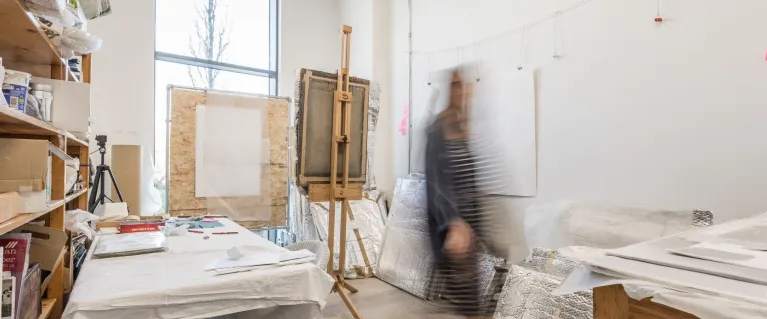
Artists' Workspace
Artists have been part of London’s story for hundreds of years and have made it the thriving, creative, diverse city it is today. Spaces where artists work have a wider economic and social value, contributing to local business growth, attracting people and investment to an area and supporting communities.
Artists’ Workspace in London
As part of the Mayors Cultural Infrastructure Plan, research has been undertaken to understand how workspace provision for London’s artists has changed since the landmark 2014 study on the subject which found that the sector was vulnerable.
Key Findings
- 67% of sites identified in 2014 as ‘at risk of closure within 5 years’ had closed by November 2017.
- The risk of closure remains high and 24% (57) of current sites providing artists’ workspace are at risk of closure within the next 5 years. This is because so few organisations own the freehold to sites (around 13%).
- Between 2014 and 2017, 52 new sites providing artists’ workspace opened – a net gain of 13 sites. Mayoral regeneration funding has supported 5 of these sites.
- Workspaces are becoming more expensive. In 2014, 56% of sites charged an average of £11+ per square foot. In 2017, this had risen to 79% of sites.
- Many operators provide space for both artists and other creative tenants to support a blended rental income model. That means not every new site provides workspace exclusively for artists.
- Sites show very high and continuous occupancy rates. There appears to have been no decline in demand from artists for workspace since 2014.
Why do artists’ workspace sites remain vulnerable?
Continued monitoring is required, as a number of factors are impacting artists’ workspace provision. These include:
- Increased price of property and land across London: This affects both leasing and purchasing property. The former model of locating artists’ workspace in cheaper parts of the city is no longer viable, as property and land across London is in high demand.
- Pressure on industrial land: Artists’ workspace providers often operate on small or light industrial sites, which are under increasing pressure in London due to steady demand from other businesses.
- Demand for similar spaces: The growth of ‘Open Workspace’ provision across London has increased demand for buildings of a similar type and scale. These buildings then no longer offer workspace for artists, but instead offer desk space.
- Planning policy: Temporary permitted development rights currently apply when changing the use of premises from business (B1(a)) to residential (C3). This has resulted in the loss of buildings which once provided artists’ workspace.
- Business rates: As artists’ workspace providers operate as umbrella organisations which house a number of smaller sole traders or businesses, they have been particularly affected by the complexity, change and expense around business rates
- Ownership: Very few artists’ workspace providers own the property which they operate. This leaves them vulnerable to rent reviews and being priced out of their locations.
What's the Mayor doing to protect and support artists’ workspace?
The Creative Land Trust
The Mayor has already committed to setting up a Creative Land Trust to secure workspace for artists at affordable rates in perpetuity.
Draft London Plan
The draft London Plan reinforces the Mayor’s commitment to providing increased support for artists’ workspace. It encourages development proposals to protect creative and artists workspace in areas where there is an identified shortage of affordable space. The Plan also sets out a framework for boroughs to secure affordable workspace below market rents, including for sectors that have cultural value.
Creative Enterprise Zones
The Mayor has launched Creative Enterprise Zones – a new initiative to designate small areas of London where artists can put down roots and creative activity is supported.
The Workspace Pledge
The Mayor’s Workspace Pledge asks boroughs to sign up to signify their commitment to protecting existing and creating new workspace.
The Good Growth Fund
The Good Growth Fund is Mayor’s £70 million regeneration programme to support growth and community development in London. Artists’ workspace operators are eligible to apply.
The Culture at Risk Office
The Mayor has set up London’s first ever Culture at Risk Office to safeguard the capital's well-loved cultural places and spaces at risk of being lost. If you know of an artists’ workspace, or other venue, at risk of closure please contact City Hall's Culture at Risk Officer, [email protected].
Finding an Artists' Workspace
If you are looking for a workspace or studio please use Studio Finder
For further information about the artists' workspace and the research please contact [email protected]
Download Artists' Workspace Study 2014
Download Creating Artists' Workspace
Need a document on this page in an accessible format?
If you use assistive technology (such as a screen reader) and need a version of a PDF or other document on this page in a more accessible format, please get in touch via our online form and tell us which format you need.
It will also help us if you tell us which assistive technology you use. We’ll consider your request and get back to you in 5 working days.